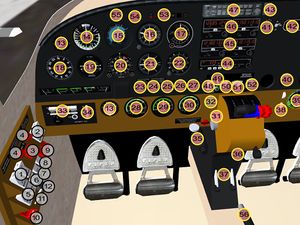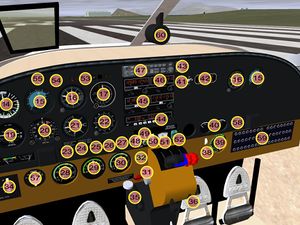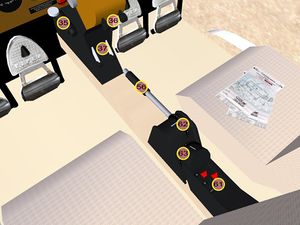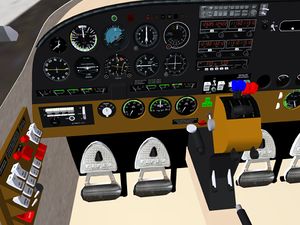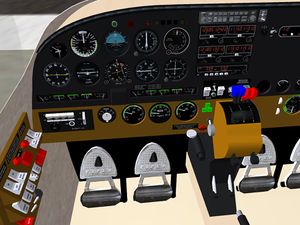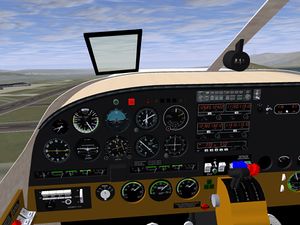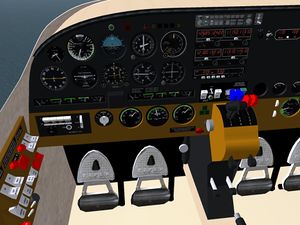Howto:Seneca II
HOWTO fly the Seneca II
These are basic instructions about how to fly the Seneca II in FlightGear. They should help you finding and operating all controls in the cockpit you need for a flight. You will also learn some basic maneuvers and procedures. They are based on real world flying procedures and should match reality quite close. But do not use this HOWTO as a guide for real-life flying. There are still some differences between reality and virtuality (e.g. there are no keys like 'P' and 'ESC' in real aircraft).
To follow this HOWTO, you need
- A running version of FlightGear
- The Seneca II aircraft from the [FlightGear Aircraft download page ] installed
- The Seneca II Checklist
- The Seneca II Panel Reference
- For the IFR part some IFR charts [e.g. from AirNav]
- Some spare time: 1 hour for the VFR part, 2 hours for the complete session
The reference screenshots may help, if you are not familiar with the location of the controls:
Basics - VFR
To keep the beginning simple, let's start on a nice sunny day in San Francisco Intl - KSFO, FlightGear's default airport. Start your FlightGear with
fgfs --aircraft=SenecaII-jsbsim
You will be placed on KSFO runway 28R with a dead aircraft blocking the runway.
In reality, you should never sit in this position without being ready for an immediate takeoff - but in our sim everything is fine here. Grab your checklist and go through the Cockpit Check and Before Start Engine lists. Your panel should look similiar to the picture on the right.
Startup, Takeoff, Straight and Level
First of all, we have to start the engines. Once again, the checklist will help us doing the right things in the correct order. The operation of the primer is not needed in the simulation, so you can safely skip the operation of the primer here, since the engines will fire regardless of priming or not. After ignition, you have to open the throttles to let the engines run at more than 1000RPM for a short time to keep them alive. Go through the After Start Engine Check. The Taxi Check is somewhat void here, since we will not taxi. Leave the flaps up - they are not needed on this long runway. The default trim position will work fine for takeoff. When the engines are running, it's time to do the nav setup. We do a straight out departure without navaids, so just twist the heading bug to the runway heading of 280. The center dot of the attitude indicator should align with the horizon line. The Before Takeoff Check will make you set the fuel selectors to on. The clearance for our little training session is: 'Climb on runway heading to 2000ft. Maintain 2000ft until further advice.' That will also serve as a departure briefing. And in case of emergency: hit the ESC-key and restart FlightGear.
D-GEAR: cleared for takeoff runway 28R
When cleared for takeoff, advance the throttle slowly to apply 40" of manifold pressure. In reality you should only advance to 39" of manifold pressure, the remaining inch will build up on the run due to ramair. A warning light in the annunciator panel will illuminate if you exceed 40". Reduce throttle on the corresponding engine in that case to avoid engine damage. When MP is stabilized, release the parking brake (Shift-B) for the takeoff-run. Maintain the centerline and observe the airspeed indicator passing the red line (minimum control speed air) and rotate at 70knots by pulling the yoke (or joystick) a little back. When airborne, accelerate past the blue line (best rate of climb single engine) to 95knots. When the runway is not sufficient for landing anymore, retract the gear and turn off the landing lights.At 500ft above the field reduce the power to 31" manifold pressure and 2500 RPM.Accelerate to 100knots climb speed for a better engine cooling. When your workload permitts, read the After Takeoff Check.
When reaching the target altitude of 2000ft, lower the nose and let the aircraft accelerate for some seconds. Adjust your pitch slowly so the vertical speed indicator shows 0fpm. Reduce the power to 28"/2400RPM. Lean the mixture a little to save some virtual fuel and get best cruise performance. Closing the cowl-flaps (use the 'Seneca' Menuitem) will give you approx. 10knots of additional airspeed. You should be now on a straight and level flight at 2000ft at some 130 knots. If you want, go to the next section or hit the 'P'-key to pause and have a coffee.
